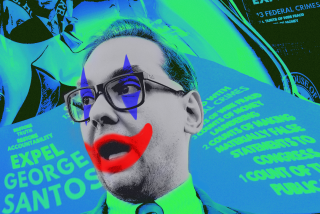Penwriters Are Leaving Their Mark on Capitol Hill
- Share via
WASHINGTON — For Christopher Heil, the first year of shorthand school was the fields of wartime France, where he used his bayonet to scratch characters in the snow in his foxhole.
“All of my buddies, they’d come say: ‘Hey look at Heil. Crazy. Shell-shocked, you know.’ I’d say: ‘Hey look guys, really, let me show you what I’m doing. You know this little line here, this is a D. And this little circle. . . .’ Oh, they thought I was gone.”
But the old Gregg School of shorthand in Chicago said he had become proficient enough between bullets to go straight to second-year courses. That was just the beginning of his career.
Now, more than four decades later, he and two other men in their 60s are closing out two centuries of tradition in Congress. Heil and Charles Gustafson in the House and William D. Mohr in the Senate are the last of the penwriters.
Whenever these three men retire, the task of recording the utterances of House and Senate members for the daily Congressional Record will fall to a younger generation using a newer technology, the stenotype machine.
Reminder of Another Era
Most House and Senate debates are recorded on the widely used little machines. Except when Gustafson, Heil and Mohr take their turn in the floor rotation, regularly offering a reminder of another era of squiggly notes and flying paper.
Their retirement--whenever they decide to go--will be more than just a passage of technology. It will be the end of a period when people talked slower and when oratory was more than a 30-second bite on television.
Moreover, it will be the end of an era of shorthand; the type of super-fast Gregg and Pittman shorthand used by Gustafson, Heil and Mohr is not taught anywhere today.
Business secretaries now learn a form of shorthand designed for the slow pace of letter dictation, not the rapid fire of congressional debate. They can compete for accuracy, but cannot touch the speed of the old system.
“They are good, but not good enough for this,” Heil said.
Business offices also cannot match the front-row seat to democracy. Fighting Nazis was more dangerous, of course, but the floors of Congress have their moments.
“It was the funniest thing you ever saw in your life,” Heil recalled.
He is speaking of the day an enraged, then-Rep. Bella Abzug, (D-N.Y.), inadvertently bowled over one of their colleagues, Edna Moyer, and went sprawling to the floor on top of her.
It was one of those rare, almost unheard-of moments when members of Congress stretch the bounds of tradition to the point that they are ordered arrested and removed from the floor.
“Poor Edna was down there on the floor, and Bella Abzug was screaming at the speaker, ‘You can’t do this to me!’ I was the one taking all this down. So that’s why I remember it so clearly.”
But Heil’s notes are lost to history because the Congressional Record isn’t a verbatim record of House and Senate floor proceedings. It is edited, and passages are often changed or deleted under the power to “revise and extend” remarks, or according to rules and tradition. Abzug had already been ordered off the House floor, and therefore was ineligible to be recorded.
Helping Out
Sometimes, the note-takers themselves, being careful not to change substance, subtly help the folks on the floor sound more congressional.
“We help these guys out,” Heil said. “We polish them up a little bit. We do some very skillful, judicial editing. Sometimes they don’t even know.”
That’s not always easy. Some members of Congress are hard to understand. Then-Rep. Teno Roncalio (D-Wyo.) was one of the champions of babble. Almost no one could understand him.
“I went to him once and said, ‘I don’t think I understood you very well,’ ” said Gustafson, the chief House reporter. “And he said, ‘Don’t worry about it. I couldn’t hardly understand myself.’ He said, ‘I’ll look it over. I’ll fix it up.’
“His head was always ahead of his tongue,” Gustafson said. “A lot of members are like that. I think many of the worst speakers are the ones I consider having the best minds.”
Then there’s the fastest mouth on the Hill, Rep. Barney Frank (D-Mass.). The fastest penwriter ever recorded handled 280 words a minute. “He (Frank) can speak up to 300 words per minute,” Heil said.
But Frank tends to be repetitious, Gustafson said, allowing them to catch up. Frank is also generous in explaining what he just said. “He’s a wonderful guy, and he’s very nice,” Gustafson said. “He’s not hard to understand. He’s just fast.”
The three have been in Congress for 15 years or more. Mohr arrived from New Jersey in 1966, Gustafson from Ohio in 1972 and Heil, also from Ohio, in 1973. All had been court reporters or had run reporting businesses for many years before that. Gustafson is 67, Heil 68 and Mohr won’t give his age. (“I like to be judged on myself and what I can do,” he said.)
The verdict on what has changed in those years was unanimous and immediate:
“People are speaking faster,” Mohr said. “Maybe it’s a sign of the times. People are rushed in their . . . activities anyway. And they get used to doing things faster, and they talk faster.”
Interviewed separately, Gustafson and Heil said the same thing.
“In the older days, you had older senators. They were more deliberate, more oratorical,” Heil said. “You had people like (Illinois Republican Everett M.) Dirksen with deep, booming voices. Now, you have young men who come from, well, they’re highly educated and they’re just used to the fast business pace of the day. . . . The younger politicians are just spitting it out faster.”
A Declining Art
Oratory has also suffered.
“I really do think oratory as an art is declining,” Heil said. “I do think years ago we had better orators.”
“I think because of television, because of greater access to media possibilities that it (oratory) has become much less important,” Gustafson said. “And I don’t think people need the oratory to be swayed or be educated. They know things already without listening to anybody explain the basics to them.
“I think people assume and probably rightly so, ‘I better start in the middle here because everybody probably knows everything I would say to begin with, so let’s start here and save time.’ ”
The art isn’t dead, however. In the House, they said, it is preserved by a handful of orators led by Speaker Jim Wright (D-Tex.) and Rep. Guy Vander Jagt (R-Mich.).
“He (Wright) has a store of poetry in his head and his vocabulary is far above average,” Gustafson said.
“He probably has the best vocabulary of any speaker we ever had in this century,” Heil said.
Don’t wait for the verdict from the Senate. Perhaps reflecting the more august nature of that body, Mohr refused to talk about individual senators.
But he will talk about Eleanor Roosevelt. Largely because of Mohr, the former first lady’s weekly press conferences have been preserved for history.
Those sessions--for women only because F.D.R.’s were men-only--were never officially recorded. But a Washington Daily News reporter took verbatim notes by Pittman shorthand, and a researcher found those notes at the University of Wisconsin. Reading someone else’s shorthand is difficult, but Mohr said he translated 90% of them “because she was a good penman.”
In one form or another, the activities of Congress have been recorded since 1789, when speeches were published in condensed form in the Annals of Congress. In 1873, the first edition of the modern Congressional Record was published, giving an allegedly verbatim gavel-to-gavel transcript.
For 185 years, until the first stenotype machine arrived in 1974, every word was recorded by hand. Before long, the stenotype system is likely to enter the computer age. Machines are available with cassettes that can be plugged into a computer and flash a translation of stenotype notes onto a screen.
Each of the three men tried the new technology, and became proficient. But they decided not to abandon their art for a machine; they stuck with a pad and pen.
“Several years ago, I thought I would see what the machine was like and start learning it on my own,” Mohr said. “But I realized that if I achieved the ultimate speed on the machine, I’d be just where I was now. So I couldn’t figure the advantage in putting in all that time and effort.”
“Shorthand is a wonderful personal art,” Heil said.
“I think I was just too lazy,” Gustafson said.
It would be romantic to believe that the penwriters think the pen is mightier than the stenotype. Wrong. “It’s (the stenotype) a superior way of doing it now, especially with the computer,” Gustafson said.
And there’s no doubt they are the last of the penwriters.
“We wouldn’t even take one,” Gustafson said. “If there were a qualified one, he’d be so old. You wouldn’t get any young reporters.”
“I just don’t think there’s any out there,” Heil said.
More to Read
Get the L.A. Times Politics newsletter
Deeply reported insights into legislation, politics and policy from Sacramento, Washington and beyond. In your inbox twice per week.
You may occasionally receive promotional content from the Los Angeles Times.








